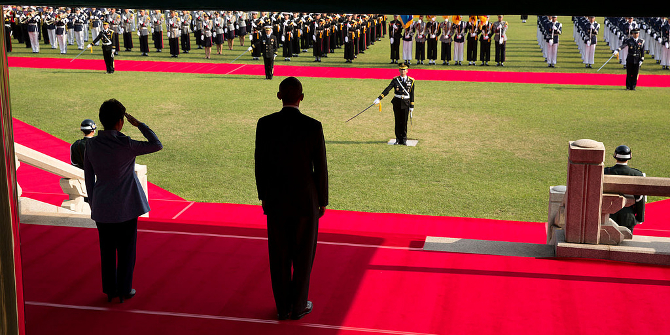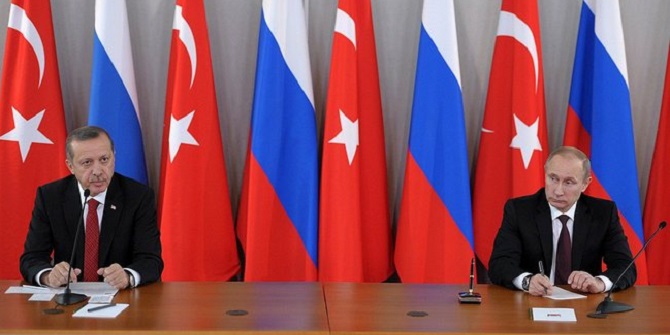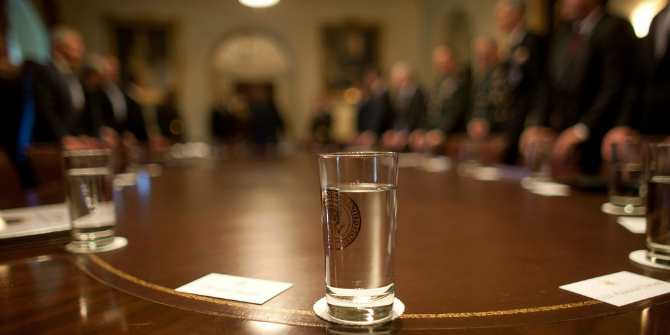 With the eyes of the world firmly placed on developments in Iraq and Israel and Gaza, it might be easy to forget the Obama Administration’s ‘pivot’ towards Asia, illustrated by the President’s tour of the region earlier this year. Sam Hazelgrove takes a close look at the state of the Asia “pivot”, writing that while the term itself may not be entirely accurate, there has still be a fundamental, yet nuanced, policy shift. He writes that much of Obama’s policy on Asia will depend on his Administration’s ability to develop a coherent approach to China.
With the eyes of the world firmly placed on developments in Iraq and Israel and Gaza, it might be easy to forget the Obama Administration’s ‘pivot’ towards Asia, illustrated by the President’s tour of the region earlier this year. Sam Hazelgrove takes a close look at the state of the Asia “pivot”, writing that while the term itself may not be entirely accurate, there has still be a fundamental, yet nuanced, policy shift. He writes that much of Obama’s policy on Asia will depend on his Administration’s ability to develop a coherent approach to China.
The Obama Administration’s foreign policy legacy will be judged, rightly or wrongly, on the successes and failures of US action (or indeed inaction) in the Middle East. It is this region, whether it is Iraq, Afghanistan, Syria, Egypt or Iran that has provoked a contentious debate on the major themes that have driven US foreign policy since the cold war. When political scientists inevitably attempt to shoe-horn a series of complex and disaggregated decisions into the moulds of realism, neo-realism, institutionalism or constructivism (and many more), they will look back at the President’s Nobel Peace Prize Speech and his more recent West Point Speech to determine, definitively, whether he was an interventionist or an isolationist, a pragmatist or an idealist, a dove or a hawk.
However, in Asia, East Asia specifically, the Administration has been pursuing a fundamental, and at the same time nuanced, shift in policy. The emphasis that the Obama Administration has placed on the importance of Asia, at least publicly, is new to the post-cold war era. It is the first time that the region has been included in a grand strategy, or at least been thought of in such terms. Whatever the tangible outcomes of this renewed focus on Asia (the Trans Pacific Partnership, for example), the shift has provoked deep thinking about the US role in Asia, and about the kind of relationship it wants with the countries in the region. For these reasons, the pivot to Asia is worthy of serious analysis, not to be overshadowed by events in the Middle East.
It is noticeable that recently commentators, perhaps tired of general narratives, have started to look past arguments concerned with the conceptual nature of the strategy, and concentrated on questions of secondary importance. For example, Joseph Nye posted on what Europe’s job, vis-à-vis the United States, regarding the pivot might be, arguing that its role consists in lending legitimacy to the demands of international organisations and expanding trade ties with countries in the region. Stephen Walt has also speculated on what Europe’s contribution might be, suggesting that NATO countering a rising China just “ain’t gonna happen.” However, the fundamental questions that help shape the pivot (such as what should the US role in Asia be; what should the nature of the relationship between the US and China be; and, how should the US build alliances in the region?) require continual reassessment and re-evaluation if we are to understand the strategy as a whole.

Earlier this year, at the Brookings Institute, scholar Kenneth Lieberthal drew attention to this issue when he questioned whether ‘pivot’ was the appropriate word to describe the strategic readjustment, rather than ‘rebalance’, or ‘reinvigorate’ (he chose “reinvigorate”). The centrepiece of his argument – “words and attention matter” – can be used as a starting point to unearth some of the more notional questions that underpin any grand strategy: how the pivot was envisioned and how has been perceived by policy makers both in the US and in East Asia.
Lieberthal asked three questions; does the pivot depend on the assumption that the Middle East and Europe will “go smoothly,” and will no longer cause problems for the United States (if you think of pivot in the literal sense of the word); does the credibility of the strategy depend on a functional Washington; and, can the US deliver the necessary economic and security measures in a prudent manner?
He was right to argue that the interpretation of words matter when understanding foreign policy. For example, if the rhetorical device is taken literally, the ‘pivot’ to Asia might suggest the US was leaving Europe and the Middle East behind in its strategic thinking. This charge has not escaped the Obama Administration. The problem is that ‘pivot’ is perhaps too suggestive, too prescriptive, and fails to allow room for manoeuvre.
However, the point of Lieberthal’s exercise is not to agonise over the literal meanings of potential alternatives to the word ‘pivot’, but to look behind the meaning of the word and find the reasons it was chosen. To do this it is worth exploring answers to Lieberthal’s other two questions, as the answers will lead to a better understanding of the strategy in its current form. When reflecting on these questions two issues with the pivot emerge.
The first problem pertains to how the Obama Administration has expressed the pivot, not just in terms of rhetoric, but in actions. Obama started his Asia tour in April by meeting Japan’s Prime Minister Shinzo Abe, and described the US-Japan alliance as “the foundation not only for our security in the Asia Pacific but also for the region as a whole.” He finished with meetings in the Philippines where he signed a new pact, which allowed for an increase in the US military presence in the region. While the US-Japan alliance is crucial for both countries, not just for military reasons, but also political, economic, and historical reasons, the tour meetings risked concentrating too closely on the US military presence in Asia, leading some to frame the trip as a “containment [of China] tour;” a charge that Obama later rebuffed.
Renewing old alliances is an important component of the Administration’s Asia strategy. If, as Tom Donilon suggests, the strategy represents “a shift toward the region that presents the most significant opportunity for the United States,” then the pivot is not just about whether the US has the necessary economic and security measures to reinvigorate old alliances, but whether it also has the capability to take advantage of new opportunities.
The second issue concerns the country that is arguably at the centre of the new strategy: China. The President’s last trip to Asia was aptly summed up by the New York Times, “On a trip that avoids Beijing, Obama keeps his eye on China.” The topic of China was unavoidable, and Obama spent much of his time, at press conferences at least, answering speculative questions about the country’s rise. While, for some, the US-China relationship might prompt discussions on Lieberthal’s third question about US military and economic capabilities in Asia, it could be argued that more pressing, or fundamental, issues to be considered are how the United States views China, the nature of its economic growth, and its ambitions in the region.
Whether the United States sees China as a competitor or a partner, or both, is unclear, and successive US administrations have struggled to clearly and concisely define the relationship: the Obama Administration’s attempts have remained, understandably, allusive. Overcoming this difficulty depends largely on formulating a coherent approach to China’s rise. Furthermore, it also depends on Washington recognising the “risks of rhetoric,” as Henry Kissinger put it: hyperbole that recklessly “attacks the basic motivations on Chinese policy,” with a domestic agenda, and without specific evidence. In other words, if the US-China relationship is central to the Asia strategy then the answer to Lieberthal’s second question is yes; the credibility of the strategy does (at least partly) depend on a functional Washington that is able to define clearly its relationship with China.
So, if not ‘pivot’ then what? The answer to this question does not lie in finding words that might be chosen to replace “pivot”, or dissecting the literal meanings of potential alternatives, but looking more closely at US posturing in the region. In fact, finding a word that reflects the shift in policy should be the least of the Administration’s concerns. For example, when Henry Kissinger travelled to China in 1971 it took most of the world, including the United States, by surprise. Despite the substantial change in attitude towards a then ideological adversary of the United States, the months preceding the visits were not occupied by a number of speeches peppered with the word “détente.” One of the most significant moments of the cold war would come to be known simply as the “Opening to China.”
Please read our comments policy before commenting.
Note: This article gives the views of the author, and not the position of USApp– American Politics and Policy, nor of the London School of Economics.
Shortened URL for this post: http://bit.ly/1ra17NZ
_________________________________________
 Sam Hazelgrove – University of Cambridge
Sam Hazelgrove – University of Cambridge
Sam Hazelgrove graduated from the University of Cambridge with an MPhil in International Relations, where his research focused on US foreign policy. He has a first class Bachelor of Arts degree in American History and Politics from the University of East Anglia. He currently works as a political researcher and contributor to Future Foreign Policy. He tweets @SamHazelgrove.







1 Comments